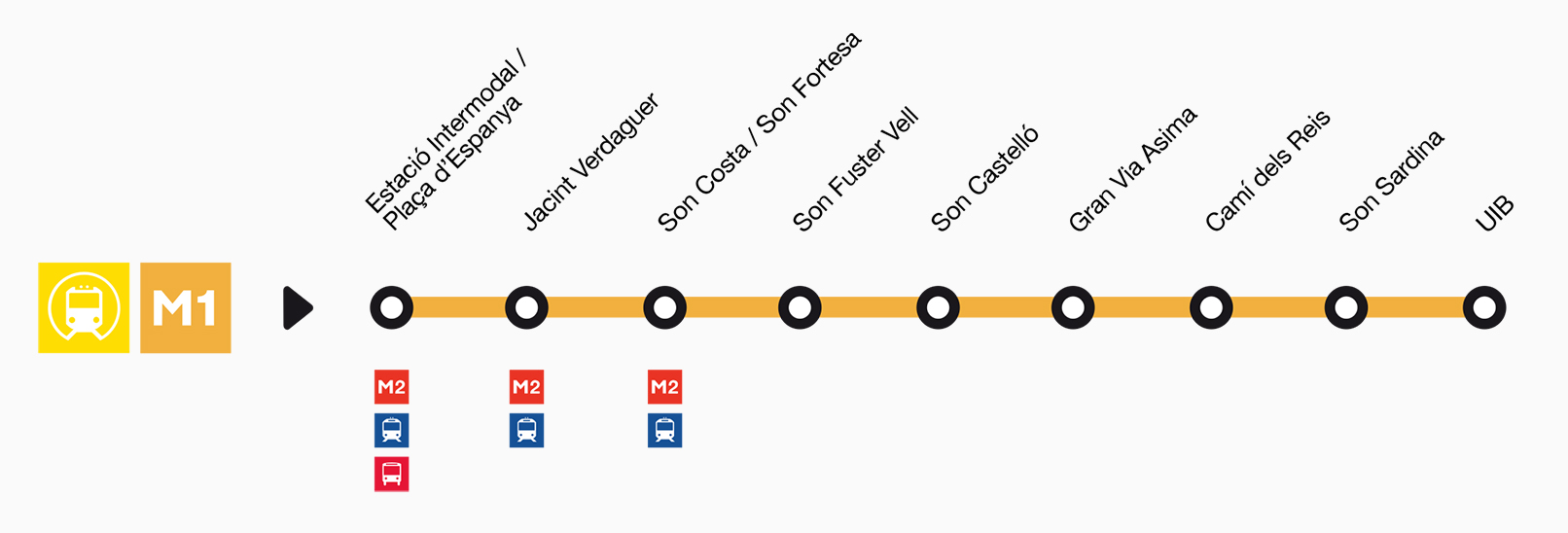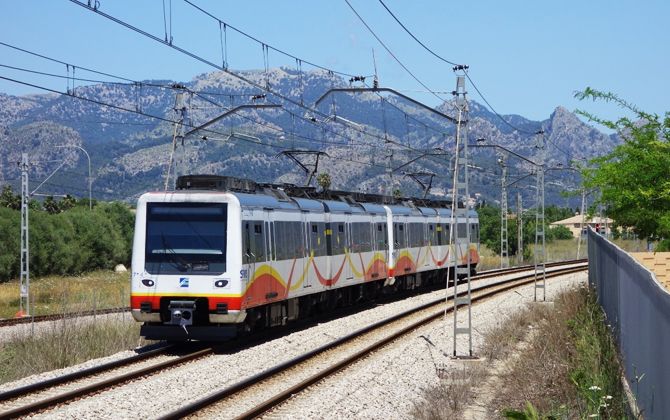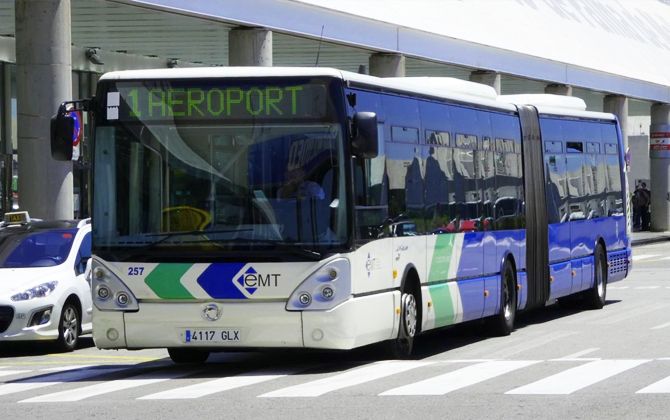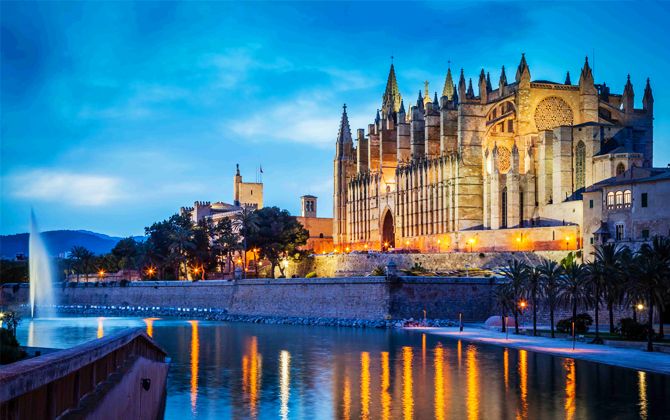The Palma Metro is one of Spain’s most compact yet essential urban rail networks, serving Palma de Mallorca in the Balearic Islands. This guide covers the system including extensions, timetables, and practical tips for residents and visitors.
The Palma Metro is a key part of Mallorca’s public transport, operated by Serveis Ferroviaris de Mallorca (SFM) under the Transport de les Illes Balears. As of 2026, it runs a single active line linking Palma’s city center with the University of the Balearic Islands and the Parc Bit technology park. The network uses meter-gauge tracks with 1,500 V DC overhead power and integrates with the island’s rail system.
The metro carries about 1.2 million passengers a year, or roughly 3,288 riders per day. Despite its small size, it connects northern residential areas to the center and major institutions. Trains are modern two-car CAF units, about 33 m long and 2.55 m wide.
Metro Map of Palma de Mallorca
The Palma Metro runs for 9.9 km (6.2 miles), mostly underground in tunnels averaging 8 meters deep. The line is oriented north–south: it starts at Palma Intermodal Station by Plaça d’Espanya, then heads through suburban districts to the university campus and the Parc Bit technology park.
From Plaça d’Espanya to Son Costa–Son Fortesa, the metro shares a four-track tunnel with the island’s regional railway. This corridor uses space efficiently while keeping metro and regional services separate. Past Son Costa–Son Fortesa, the metro switches to its own alignment, briefly surfacing near Son Sardina before continuing to its northern terminals.
Map of Palma Metro showing different lines. Click on the map to enlarge it or download the Palma Metro map in PDF format.
Lines and Stations of Palma Metro
Line M1
Line M1 is the system’s backbone. It has ten stations serving residential, commercial, and institutional areas in northern Palma. The line starts at Palma Intermodal–Plaça d’Espanya and, after the July 2026 extension, ends at Parc Bit.
- Palma Intermodal–Plaça d’Espanya is the main terminus and interchange. It sits three levels underground and connects directly to regional trains, city buses, and intercity coaches. Elevators and step-free routes provide full accessibility.
- Jacint Verdaguer is fully accessible and a key interchange with regional rail. It opened to regional services in March 2007 and to metro services in April 2007, with separate platforms for each.
- Son Costa–Son Fortesa is an underground station serving metro and, on weekends and holidays, regional trains. Four tracks, separated by barriers, keep services distinct.
- Son Fuster Vell is underground with two tracks and side platforms, located between Son Costa and Gran Vía Asima.
- Son Castelló serves the surrounding industrial zone. It is underground with side platforms and handles heavy commuter flows to local businesses.
- Gran Vía Asima serves only M1, providing access to nearby housing and businesses between Son Castelló and Son Fuster Vell.
- Camí dels Reis serves the Son Castelló industrial district and is important for worker access across this commercial area.
- Son Sardina is the only surface station on M1. It sits between Universidad de las Islas Baleares and Camí dels Reis and is close to the Sóller Railway tracks.
- Universidad de las Islas Baleares (UIB) serves the island’s main campus. It is a major destination for students and staff, with high volumes during the academic year.
- Parc Bit is the newest station (July 2026). It extends service to the science and technology park, improving access for tech firms and research centers.
Line M2
Line M2 operated from March 2013 to April 29, 2022. It ran as an urban service on regional rail tracks between Plaça d’Espanya and Marratxí, stopping at ten intermediate stations. Trains ran every 20 minutes and used metro rolling stock when M1 did not need it.
The route included Jacint Verdaguer and Intermodal Station (shared with M1), plus Son Fuster, Son Costa–Son Fortesa, Pont d’Inca, Virgen de Lluc, Marratxí, Pont d’Inca Nou, Polígono de Marratxí, and Son Cladera/Es Vivero. After M2 ended, regional services T1, T2, and T3 took over these stops with better coordinated schedules.
Schedule and Timetables
On weekdays during the academic term, M1 runs from about 6:30 AM (06:30) to 10:00 PM (22:00). Trains generally run every 20 minutes, with slightly higher frequency in the morning peak.
On university holidays, weekday headways shift to every 30–40 minutes while maintaining similar hours. On Saturdays, service runs from 7:00 AM (07:00) to 3:00 PM (15:00). Trains run every 30 minutes in term time and hourly during holidays. There is no Sunday service.
The end-to-end trip from Palma Intermodal–Plaça d’Espanya to Parc Bit takes about 15 minutes. Station spacing yields typical intervals of 1–2 minutes between stops.
Prices, Tickets, and Cards
| Ticket Type | Price (EUR) | Price (USD) | Validity |
|---|---|---|---|
| Single Journey | €1.80 | $1.95 | One journey on M1 |
| 10-Journey Card | €15.00 | $16.25 | 10 individual journeys on M1 |
| TIB Zonal System | Variable (€1.80–€7.20) | $1.95–$7.80 | Fare by zone hops (0–4) |
| Intermodal Card | Variable | Variable | Multiple transport modes |
The Palma Metro uses a simple fare system. A single ticket costs €1.80 ($1.95) and covers any trip between two stations on M1. Buy tickets at vending machines in all stations using cash or card. Palma Intermodal also has staffed ticket offices for sales and help.
Frequent riders can use prepaid options. A 10-journey card costs €15.00 ($16.25), cheaper than buying singles. It is not rechargeable; replace it when all trips are used.
The metro integrates with the TIB zonal system for island-wide travel on trains, buses, and the metro. Fares depend on zone hops: from €1.80 ($1.95) for 0 hops up to about €7.20 ($7.80) for 4 hops. With an Intermodal Card or a bank card, you get up to two transfers across TIB modes within the allowed time window.
Connections
Line M1
Palma Intermodal–Plaça d’Espanya is Mallorca’s main transport hub. It links the metro with regional trains, city buses, and intercity coaches. Regional lines T1 (Inca), T2 (Sa Pobla), and T3 (Manacor) connect across the island. The underground bus terminal handles intercity routes, while surface stops serve EMT Palma city buses.
City bus links from Plaça d’Espanya cover the whole city. The key route is A1 to the airport, running every 15–20 minutes with a typical end-to-end time of about 30 minutes. Other routes serve residential areas, shopping districts, and tourist sights.
Son Sardina connects to the historic Sóller Railway, a narrow-gauge line to the mountain town of Sóller—ideal for combining a metro ride with a heritage trip. Other M1 stations mainly connect to local buses. Universidad de las Islas Baleares also links to campus shuttles and local services.
Line M2
Line M2 ended metro operations in April 2022. Its corridor is now covered by integrated regional trains. Jacint Verdaguer and Intermodal Station still serve both M1 and regional services. The former M2 stops between Palma and Marratxí are served by regional trains with similar frequency and connectivity.
Marratxí is a key interchange for regional rail and intercity buses to central and eastern Mallorca. Platform layouts make transfers straightforward, even though the dedicated M2 service no longer runs.
Connection to the Airport
The metro does not go to PMI Airport. Use the A1 airport bus from Plaça d’Espanya Intermodal Station. Service runs daily from 4:15 AM to 12:07 AM (00:07) with 15–20 minute headways. The trip takes about 30 minutes and makes 10 stops across Palma.
Fares for A1: €5.00 ($5.40) one way, €8.00 ($8.65) round trip. Pay with cash (exact change recommended) or prepaid cards; bank cards are not accepted on board.
Taxi is the fastest door-to-door option. The ride to central Palma is roughly 15 minutes. Prices vary by destination and time of day and are higher than the bus. Car rentals are available at the airport for maximum flexibility.
Tips for Navigating the Palma Metro
- Signage and announcements. Signs in Spanish and Catalan, with English at key tourist stations; electronic boards show next trains; major hubs broadcast multilingual audio, including airport-bus info.
- Accessibility. Elevators at major stations (Jacint Verdaguer fully equipped); platforms support wheelchairs and mobility devices; tactile paving and clear layouts help first-time visitors.
- When to ride. Peak hours: weekdays 07:30–09:30 and 17:00–19:00; for fewer crowds, go mid-morning or mid-afternoon; weekends run less frequently but are usually quieter except during events or peak tourist season.
Rules and Regulations on the Palma Metro
- Animals. Guide and certified service dogs are allowed; pet dogs are generally not permitted.
- Conduct. No smoking, alcohol, or loud music; food and drinks are allowed—keep the system clean; use designated spaces for luggage and large bags.
- Tickets and enforcement. Validate at entry gates; fare inspections are routine and fines apply; CCTV operates on trains and in stations; emergency intercoms connect directly to control centers.
Future Expansions
The latest addition opened July 2, 2026: the Parc Bit extension, 1.4 km (0.87 miles) and one new station. Investment: €28.9 million (about $31.5 million). It combines underground, trench, and surface sections to serve the tech park and is expected to lift ridership by ~25%.
A major project in planning would extend rail to Alcúdia: 17.1 km (10.6 miles) from Sa Pobla to the Port of Alcúdia, including a 5 km (3.1 miles) tunnel under the Puigs de Son Fe and Sant Martí and a 4.5 km (2.8 miles) tram-train through Alcúdia’s center. Budget: €225.5 million (about $246 million). Target completion: 2031.
Another proposal would extend service from Palma to Calvià via Son Espases Hospital: roughly 20 km (12.4 miles). It aims to connect the island’s main hospital and busy resorts along Palma Bay’s west, easing traffic and supporting sustainable travel.
Long-term ideas also include a tram link between Palma’s center and the airport. Timelines and funding are still in development. The broader goal: raise public-transport’s share of all trips to 25% by boosting connectivity and frequency across Mallorca.
Fun Facts
- The Palma Metro is among Spain’s smallest metro systems: one active line serving a metro area of about 400,000 people. Despite its size, it has full metro features—underground stations, dedicated tracks, and modern electric trains—distinct from tram or light-rail systems.
- The fleet includes six two-car CAF units, each 33 m long and holding about 200 passengers. Trains have air conditioning, electronic info displays, and accessibility features. They run on 1,000 mm meter-gauge track, the same standard as Mallorca’s wider rail network—useful for future integration.
- Son Sardina is the only surface station on M1, offering brief open-air views. It sits next to the historic Sóller Railway, letting riders pair a modern metro trip with a century-old heritage ride.
- Top speed is 100 km/h (62 mph) on longer underground stretches; averages are lower due to frequent stops. Platforms are built for 80 m trains (0.08 km / 0.05 miles), leaving room to lengthen trains if demand grows. The system uses Automatic Train Protection (ATP) for safety and precise timing.
History of the Palma Metro
Construction began in January 2005 as part of Mallorca’s transport modernization, with an initial budget of €235 million (about $254 million). Most underground sections used cut-and-cover, with restored surface areas turned into linear parks.
The metro opened on April 25, 2007, offering free trial rides. Operations were suspended on September 22, 2007, after flooding affected several tunnel segments. The causes included inadequate drainage and construction-stage water management, which undermined safety and reliability.
A technical audit costing €29,900 (about $32,300) found broader issues beyond flooding, including signaling faults and concerns at the Intermodal terminus. Repairs and upgrades pushed total costs to €312 million (about $337 million), a 33% overrun. The fast build schedule contributed to these problems.
Service resumed on July 28, 2008, after extensive works: upgraded drainage, stronger safety protocols, and improved signaling. Since then, the system has run continuously with regular maintenance and periodic modernizations.
Nearby Attractions
- Catedral de Mallorca. Palma’s Gothic cathedral is a short walk from Plaça d’Espanya station. Highlights: vast rose windows, intricate stonework, and a museum of religious art and historical pieces. Nearby are medieval lanes, boutiques, and restaurants with Mallorcan cuisine.
- Castell de Bellver. A unique 14th-century circular castle overlooking the city and the Mediterranean. The museum covers Palma’s history from Roman times to today, with strong maritime themes. Its architecture and hilltop views make it ideal for photos and culture lovers.
- Passeig des Born. The city’s premier shopping and entertainment boulevard, lined with cafés, restaurants, and boutiques. Pedestrian-friendly, with outdoor dining, street performances, and seasonal festivals. Easy metro access from Plaça d’Espanya.
- University of the Balearic Islands (UIB). Directly served by the M1 terminus. Offers modern facilities, botanical gardens, and public cultural venues. Hosts conferences and exhibitions year-round, with access to nearby nature areas and hiking trails.
- Parc Bit. Newly connected via the July 2026 extension. A tech and business park with contemporary architecture and landscaped public spaces. Includes restaurants, cafés, and walking paths, emphasizing sustainability and environmental integration.





